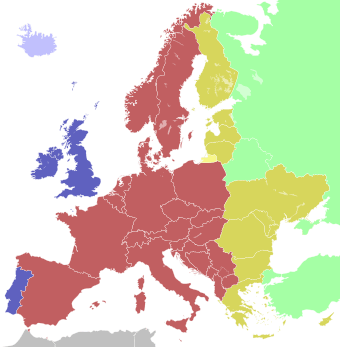Eastern European Summer Time facts for kids

Time zones of Europe in relation to UTC:
Light colours indicate countries that do not observe summer time.
| blue | Western European Time (UTC+0) Western European Summer Time (UTC+1) |
| light blue | Western European Time (UTC+0) |
| red | Central European Time (UTC+1) Central European Summer Time (UTC+2) |
| yellow | Eastern European Time (UTC+2) Eastern European Summer Time (UTC+3) |
| orange | Kaliningrad Time (UTC+3) |
| green | Further-eastern European Time (UTC+3), a.k.a. Moscow Time |
Eastern European Summer Time (EEST) is a special time zone. It is 3 hours ahead of Coordinated Universal Time (UTC+3). This time is used as a summer daylight saving time. Many countries in Europe, North Africa, and the Middle East use it. During the winter, these places switch to Eastern European Time (UTC+2).
Where is Eastern European Summer Time Used?
Many countries and areas use Eastern European Summer Time during the summer months. Here is a list of some of them:
- Belarus: Used EEST from 1991 to 2011. Now, Belarus uses Moscow Time all year.
- Bulgaria: Has used EEST regularly since 1979.
- Cyprus: Has used EEST regularly since 1979. Northern Cyprus switched back to Eastern European Time in October 2017.
- Egypt: Used EEST for some periods. This included 1970-2011 and again from 2014-2015.
- Estonia: Used Moscow Summer Time from 1981-1988. It has used EEST regularly since 1989.
- Finland: Has used EEST regularly since 1981.
- Greece: Has used EEST regularly since 1975.
- Israel: Has used EEST regularly since 1948.
- Jordan: Has used EEST since 1985.
- Latvia: Used Moscow Summer Time from 1981-1988. It has used EEST regularly since 1989.
- Lebanon: Has used EEST since 1984.
- Lithuania: Used Moscow Summer Time from 1981-1988. It has used EEST regularly since 1989. In 1998, it briefly changed to Central European Summer Time. But it returned to EEST in 2003.
- Moldova: Used Moscow Summer Time from 1981-1989. It has used EEST regularly since 1991.
- Romania: Has used EEST regularly since 1979.
- Russia (Kaliningrad): Used Moscow Summer Time from 1981-1990. It has used EEST regularly since 1991.
- Syria: Has used EEST since 1983.
- Turkey: Used EEST from 1970-1978 and 1985-2016. Now, Turkey uses Turkey Time all year.
- Ukraine: Used Moscow Summer Time from 1981-1989. It has used EEST regularly since 1992. However, some parts of Ukraine, like Crimea, Donetsk, and Luhansk, switched to Moscow Time in March 2014.
In 1991, EEST was also used in the Moscow and Samara time zones in Russia.
See also
 In Spanish: Horario de verano de Europa oriental para niños
In Spanish: Horario de verano de Europa oriental para niños

All content from Kiddle encyclopedia articles (including the article images and facts) can be freely used under Attribution-ShareAlike license, unless stated otherwise. Cite this article:
Eastern European Summer Time Facts for Kids. Kiddle Encyclopedia.
